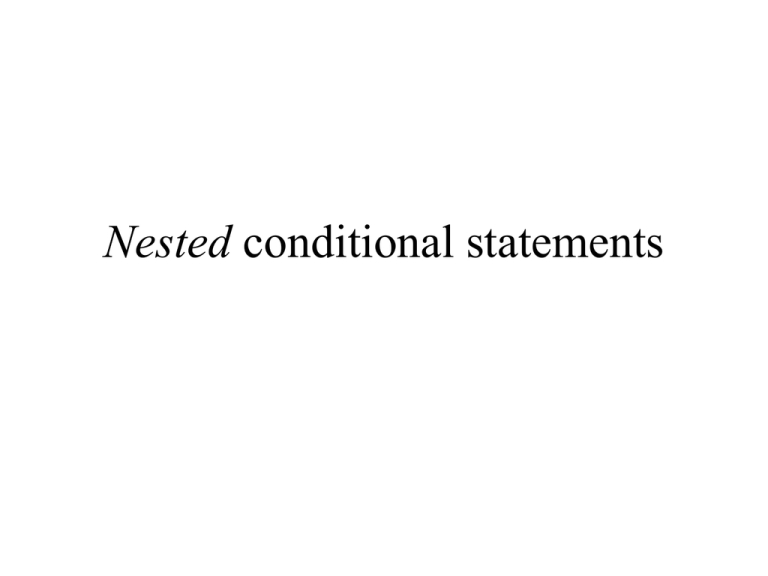
Nested conditional statements
Previously discussed
• Conditional statements discussed so far:
• if-statement
• if-else-statement
• Syntax of the if-statement:
if ( CONDITION )
ONE-statement
Previously discussed (cont.)
• Syntax of the if-else-statement:
if ( CONDITION )
ONE-statement
else
ONE-statement
Nested conditional statements
• Fact:
• A conditional statement (i.e., an if-statement or an ifelse-statement) is also a statement
• Therefore:
• We can use an if-statement or an if-else-statement in
the then-part (and in the else-part) of a conditional
statement !!!
Nested conditional statements (cont.)
• Nested conditional statement:
• Nested conditional statement = a conditional statement
where the then-part and/or the else-part contains
another conditional statement
Nested conditional statements (cont.)
• Note:
• You can nest conditional statement arbitrarily deep
• Obviously, deeper nesting makes the program difficult
to understand
• You should:
• Use nested conditional statements only when
necessary
• Try not to nest conditional statements too
deeply
Programming example: determine the
price for a hair cut
• Hair cut pricing of a saloon:
• Male customer:
• Boys (age ≤ 13): $10
• Men (age > 13): $15
• Female customer:
• Girls (age ≤ 13): $12
• Women (age > 13): $25
Programming example: determine the
price for a hair cut (cont.)
• Write a program that:
• Reads in the sex and the age
• Prints the price of the hair cut.
Programming example: determine the
price for a hair cut (cont.)
• Algorithm:
Programming example: determine the
price for a hair cut (cont.)
• Java program:
public class NestedIf01
{
public static void main(String[] args)
{
char sex;
int age, price = 0;
Scanner in = new Scanner(System.in); // Construct Scanner object
sex = in.next().charAt(0);
// Read in next char into sex
age = in.nextInt();
// Read in next integer into age
if ( sex == 'M' )
{ // Then-part of outer if-else statement
if ( age <= 13 )
{
price = 10; // Case: boy <-- then-part of inner if-else
}
Programming example: determine the
price for a hair cut (cont.)
else
{
price = 15;
// Case: man <-- else-part of inner if-else
}
}
else
{ // Else-part of outer if-else statement
if ( age <= 13 )
{
price = 12; // Case: girl <-- then-part of inner if-else
}
else
{
price = 25; // Case: woman <-- else-part of inner if-else
}
}
System.out.println("Price = " + price);
}
}
Programming example: determine the
price for a hair cut (cont.)
• Explanation:
• Suppose the user enters: sex = 'M' and age = 11
• Then the condition of the outer if-else-statement is
satisfied and executes only the then-part of the outer ifelse-statement:
// Then-part of outer if-else statement
if ( age <= 13 )
{
price = 10; // Case: boy <-- then-part of inner if-else
}
else
{
price = 15; // Case: man <-- else-part of inner if-else
}
Programming example: determine the
price for a hair cut (cont.)
• Since the then-part of the outer if-else-statement is an if-elsestatement, and the condition age <= 13 is satisfied, it will
only execute the then-part:
price = 10;
Programming example: determine the
price for a hair cut (cont.)
• Graphically: path taken by program when input is sex = 'M'
(male) and age = 11
Programming example: determine the
price for a hair cut (cont.)
Notice that only the statement(s) in then-part of the
inner and outer if-else-statements are executed
(because the conditions in the inner and outer if-elsestatements are satisfied)
Programming example: determine the
price for a hair cut (cont.)
• Another example: path taken by program when input is sex
= 'F' (female) and age = 25
Programming example: determine the
price for a hair cut (cont.)
• Note:
• The expression in.next() reads in a string from the
keyboard
• The expression in.next().charAt(0) returns the first
character in a string from read from the keyboard
Programming example: determine the
price for a hair cut (cont.)
• Example Program: (Demo above code)
– Prog file:
http://mathcs.emory.edu/~cheung/Courses/170/Syllabus/06/Progs/
NestedIf01.java
• How to run the program:
• Right click on link and save in a scratch directory
• To compile: javac NestedIf01.java
• To run:
java NestedIf01
Programming example: assign a letter
grade to a number grade
• Letter grade assignment:
• grade ≥ 90:
A
• 80 ≤ grade < 90:
B
• 70 ≤ grade < 80:
C
• 60 ≤ grade < 70:
D
• grade < 60:
F
Programming example: assign a letter
grade to a number grade (cont.)
• Write a program that:
• Reads in a number grade
• Prints the letter grade.
Programming example: assign a letter
grade to a number grade (cont.)
• Algorithm using non-nested if-statements:
Programming example: assign a letter
grade to a number grade (cont.)
• Java program:
import java.util.Scanner;
public class Grade01
{
public static void main(String[] args)
{
double ng;
String lg = "";
Scanner in = new Scanner(System.in); // Construct Scanner object
Programming example: assign a letter
grade to a number grade (cont.)
System.out.print("Enter numbger grade: ");
ng = in.nextDouble(); // Read in next number into ng
if ( ng >= 90 )
lg = "A";
if ( 80 <= ng && ng < 90 )
lg = "B";
if ( 70 <= ng && ng < 80 )
lg = "C";
if ( 60 <= ng && ng < 70 )
lg = "D";
if ( ng < 60 )
lg = "F";
System.out.println("Letter grade = " + lg);
}
}
Programming example: assign a letter
grade to a number grade (cont.)
• Example Program: (Demo above code)
– Prog file:
http://mathcs.emory.edu/~cheung/Courses/170/Syllabus/06/Progs/
Grade01.java
• How to run the program:
• Right click on link and save in a scratch directory
• To compile: javac Grade01.java
• To run:
java Grade01
Programming example: assign a letter
grade to a number grade (cont.)
• Short-coming of the algorithm:
• It is inefficient
Because the algorithm will always perform 5 individual
tests (in the 5 different if-statements
Programming example: assign a letter
grade to a number grade (cont.)
• Fact:
• The different cases are mutually disjoint
E.g., when the first condition passes (i.e., grade ≥ 90),
then the other 4 subsequent tests will all fail
Programming example: assign a letter
grade to a number grade (cont.)
The algorithm will still have to go through these
"useless" tests to reach the print statement
• We can make use of the if-else-statement to shorten
the execution
Improved algorithm to find numeric grade
• Improved algorithm to assign a letter grade:
Improved algorithm to find numeric grade
(cont.)
• Explanation:
• The first if-else statement breaks the cases into: ng ≥ 90
and ng < 90:
Improved algorithm to find numeric grade
(cont.)
If ng ≥ 90, we can assign lg = "A";
Otherwise, the execution will enter the else-part
Improved algorithm to find numeric grade
(cont.)
• The second if-else statement knows that ng < 90 !!! It uses
the test ng >= 80 to break the cases into: 80 ≤ ng < 90 and ng
< 80:
Improved algorithm to find numeric grade
(cont.)
Because we know that ng < 90 when we are inside the elsepart of the first if-else statement, when ng ≥ 80, we can
assign lg = "B"; because 80 < ng ≤ 90
Otherwise, the execution will enter the else-part of the second
if-else statement
Inside the else-part of the second if-else statement, we know
(for sure) that ng < 80.
•
The rest of the algorithm follows the same reasoning
process...
Improved algorithm to find numeric grade
(cont.)
• Program in Java: (I omitted the import statement for
brevity)
public class Grade02
{
public static void main(String[] args)
{
double ng;
String lg = "";
Scanner in = new Scanner(System.in); // Construct Scanner object
ng = in.nextDouble(); // Read in next number into ng
Improved algorithm to find numeric grade
(cont.)
if ( ng >= 90 )
lg = "A";
else
{
if ( ng >= 80 )
lg = "B";
else
{
if ( ng >= 70 )
lg = "C";
else
{
if ( ng >= 60 )
lg = "D";
else
lg = "F";
}
}
}
System.out.println("Letter grade = " + lg);
}
}
Two-way selection
• A two-way selection is a choice between 2 mutually
exclusive cases:
Two-way selection (cont.)
• The if-else-statement is known as a two-way selection
statement because it can use to make a choice between 2
mutually exclusive cases:
A three-way selection construct
• A two-way selection is a choice between 3 mutually
exclusive cases:
The choices of A, B and C are mutually exclusive.
A three-way selection construct (cont.)
• A common way to ensure that the 3 choices are mutually
exclusive is as follows:
A three-way selection construct (cont.)
• The 3-way selection construct can be implemented using
the following nested if-else statements:
A three-way selection construct (cont.)
• Notes:
• The statement(s) S1; are executed only when condition1
= true
• The statement(s) S2; are executed only when
(condition1 = false and condition2 = true)
• The statement(s) S3; are executed only when
(condition1 = false and condition2 = false)
Each of the conditions are mutually excusive
A three-way selection construct (cont.)
• The 3-way selection written in Java:
if ( conditionX )
{
statements executed only when:
conditionX = true
}
else
{
if ( conditionY )
--+
{
|
statements executed only when: |
conditionX = false |
and conditionY = true |
}
| One statement!!
else
|
{ |
statements executed only when: |
conditionX = false |
and conditionY = false |
}
--+
}
A three-way selection construct (cont.)
• Since there is one statement in the else-part, we do not
need to use a block
A three-way selection construct (cont.)
• The popular way to write a 3-way selection in Java:
if ( conditionX )
{
statements executed only when:
conditionX = true
}
else if ( conditionY )
{
statements executed only when:
conditionX = false
and conditionY = true
}
else
{
statements executed only when:
conditionX = false
and conditionY = false
}
--+
|
|
|
|
| One statement!!
|
|
|
|
|
--+
The N-way selection construct
• The 3-way selection construct can be generalized into an
N-way selection
The N-way selection construct (cont.)
A N-way selection construct looks like the following:
if ( condition1 )
{
S1; (one or more statements)
}
else if ( condition2 )
{
S2; (one or more statements)
}
else if ( condition3 )
{
S3; (one or more statements)
}
...
else if ( conditionN-1 )
{
SN-1; (one or more statements)
}
else
{
SN; (one or more statements)
}
The N-way selection construct (cont.)
• Notes:
• S1 will be executed (only) when condition1 = true
• S2 will be executed (only) when (condition1 = false and
condition2 = true)
• S3 will be executed (only) when (condition1 = false,
condition2 = false and condition3 = true)
• And so on...
The N-way selection construct (cont.)
• Example: the number grade program can be written using
an N-way selection
public class Grade03
{
public static void main(String[] args)
{
double ng;
String lg = "";
Scanner in = new Scanner(System.in); // Construct Scanner object
ng = in.nextDouble(); // Read in next number into ng
The N-way selection construct (cont.)
if ( ng >= 90 )
{
lg = "A";
}
else if ( ng >= 80 )
{
lg = "B";
}
else if ( ng >= 70 )
{
lg = "C";
}
else if ( ng >= 60 )
{
lg = "D";
}
else
{
lg = "F";
}
System.out.println("Letter grade = " + lg);
}
}
The N-way selection construct (cont.)
• Example Program: (Demo above code)
– Prog file:
http://mathcs.emory.edu/~cheung/Courses/170/Syllabus/06/Progs/
Grade03.java
• How to run the program:
• Right click on link and save in a scratch directory
• To compile: javac Grade03.java
• To run:
java Grade03








